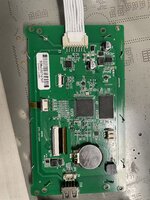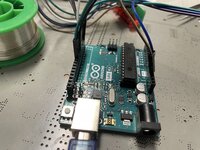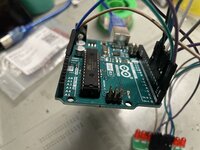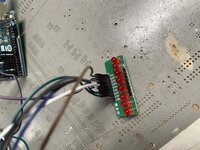Justinli
Member level 4
I'm trying to make the flowing lights light up, but I'm not sure if there's something wrong with the code. I've written five different brightness modes, but the results seem similar.
Please don't blame me, I'm new to this.
I use Arduino UNO ( http://www.arduino.cc/ )
and STONE STVI050WT-03 ( http://www.stoneitech.com/product/by-application/industrial-type/stvi050wt-03.html )
Please don't blame me, I'm new to this.
I use Arduino UNO ( http://www.arduino.cc/ )
and STONE STVI050WT-03 ( http://www.stoneitech.com/product/by-application/industrial-type/stvi050wt-03.html )
Code:
int t = 40;
int rnd =5;
int pat1t =75;
void setup()
{
for(int i=3; i<=12; i++)
pinMode(i,OUTPUT);
}
void loop(){
for(int i=0; i<=rnd; i++) {
pat1();}
for(int i=0; i<=rnd; i++){
pat2();}
for(int i=0; i<=rnd; i++) {
pat3();}
for(int i=0; i<=rnd; i++) {
pat4();}
for(int i=0; i<=rnd; i++){
pat5();}
for(int i=0; i<=rnd; i++) {
pat6();}
for(int i=0; i<=rnd; i++) {
pat7();}
for(int i=0; i<=rnd; i++) {
pat8();}
for(int i=0; i<=rnd; i++) {
pat9();}
}
void pat1(){
for(int i=3; i<=12; i++) {
digitalWrite(i,HIGH);
delay(pat1t);
digitalWrite(i,LOW);
}
for(int i=11; i>=4; i--) {
digitalWrite(i,HIGH);
delay(pat1t);
digitalWrite(i,LOW);
}
}
void pat2(){
for(int i=3; i<=12; i++) {
digitalWrite(i,HIGH);
digitalWrite(i-1,HIGH);
digitalWrite(i+1,HIGH);
delay(100);
digitalWrite(i,LOW);
digitalWrite(i-1,LOW);
digitalWrite(i+1,LOW);
}
for(int i=11; i>=4; i--) {
digitalWrite(i,HIGH);
digitalWrite(i-1,HIGH);
digitalWrite(i+1,HIGH);
delay(100);
digitalWrite(i,LOW);
digitalWrite(i-1,LOW);
digitalWrite(i+1,LOW);
}
}
void pat3(){
for(int i=3; i<=12; i=i+2) {
digitalWrite(i,HIGH);
delay(100);
digitalWrite(i,LOW);
}
for(int i=12; i>=3; i=i-2) {
digitalWrite(i,HIGH);
delay(100);
digitalWrite(i,LOW);
}
}
void pat4(){
for(int i=3; i<=12; i++) {
digitalWrite(i,HIGH);
delay(100);
}
for(int i=12; i>=2; i--) {
digitalWrite(i,HIGH);
delay(100);
digitalWrite(i,LOW);
}
}
void pat5(){
for(int i=3; i<=12; i++) {
digitalWrite(i,HIGH);
}
delay(100);
for(int i=3; i<=12; i++) {
digitalWrite(i,LOW);
}
delay(100);
}
void pat6(){
for(int i=3; i<=8; i++) {
digitalWrite(i,HIGH);
}
for(int i=8; i<=12; i++) {
digitalWrite(i,LOW);
}
delay(200);
for(int i=3; i<=8; i++) {
digitalWrite(i,LOW);
}
for(int i=8; i<=12; i++) {
digitalWrite(i,HIGH);
}
delay(200);
}
void pat7(){
for(int i=3; i<=12; i=i+2) {
digitalWrite(i,HIGH);
}
for(int i=4; i<=12; i=i+2) {
digitalWrite(i,LOW);
}
delay(200);
for(int i=3; i<=12; i=i+2) {
digitalWrite(i,LOW);
}
for(int i=4; i<=12; i=i+2) {
digitalWrite(i,HIGH);
}
delay(200);
}
void pat8(){
digitalWrite(7,HIGH);
digitalWrite(8,HIGH);
delay(t);
digitalWrite(7,LOW);
digitalWrite(8,LOW);
delay(t);
digitalWrite(6,HIGH);
digitalWrite(9,HIGH);
delay(t);
digitalWrite(6,LOW);
digitalWrite(9,LOW);
delay(t);
digitalWrite(5,HIGH);
digitalWrite(10,HIGH);
delay(t);
digitalWrite(5,LOW);
digitalWrite(10,LOW);
delay(t);
digitalWrite(4,HIGH);
digitalWrite(11,HIGH);
delay(t);
digitalWrite(4,LOW);
digitalWrite(11,LOW);
delay(t);
digitalWrite(3,HIGH);
digitalWrite(12,HIGH);
delay(t);
digitalWrite(3,LOW);
digitalWrite(12,LOW);
delay(t);
digitalWrite(4,HIGH);
digitalWrite(11,HIGH);
delay(t);
digitalWrite(4,LOW);
digitalWrite(11,LOW);
delay(t);
digitalWrite(5,HIGH);
digitalWrite(10,HIGH);
delay(t);
digitalWrite(5,LOW);
digitalWrite(10,LOW);
delay(t);
digitalWrite(6,HIGH);
digitalWrite(9,HIGH);
delay(t);
digitalWrite(6,LOW);
digitalWrite(9,LOW);
delay(t);
}
void pat9(){
for(int i=3; i<=12; i++) {
digitalWrite(i,HIGH);
}
for(int i=3; i<=12; i++) {
digitalWrite(i,LOW);
delay(100);
digitalWrite(i,HIGH);
}
for(int i=11; i>=4; i--) {
digitalWrite(i,LOW);
delay(100);
digitalWrite(i,HIGH);
}
}
Last edited by a moderator:



